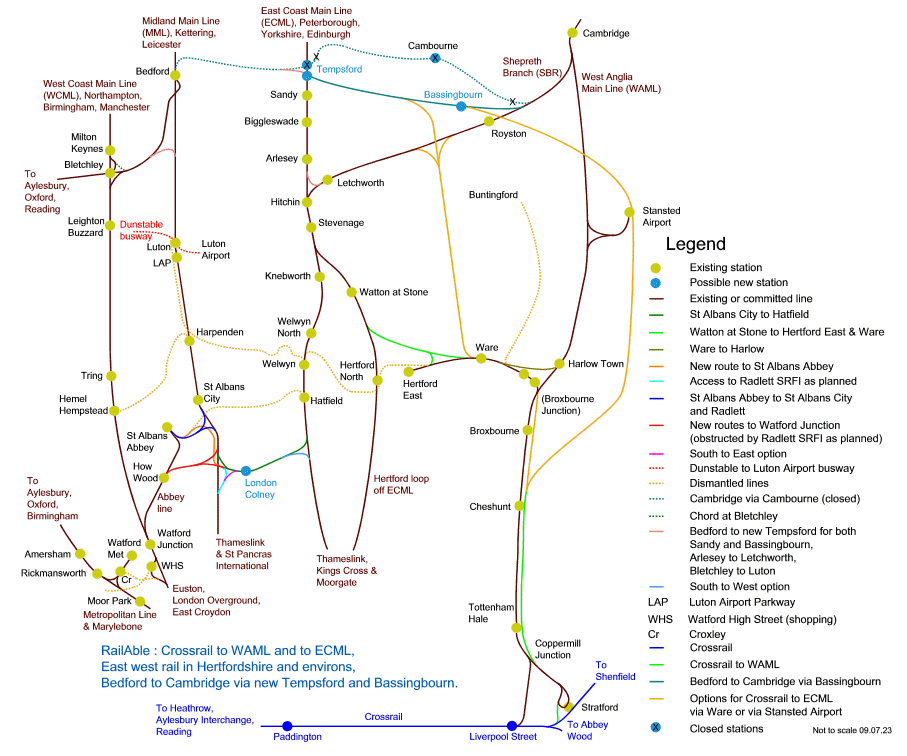With an emphasis on the London area, RailEnable researches an improved rail network. We believe in travel by train. Rail is socially inclusive and better for the environment. Welcome therefore to RailEnable. We hope you find our published research interesting.
RailEnable is also known as RailAble (RailAble.com).
We have five current projects :
Firstly, concerning travel in the Oxford to Cambridge arc, there seems to be a good business case for a railway line between St Albans and Hatfield.
Secondly, concerning the East Coast Main Line (ECML), we discuss the possibility of Elizabeth line services via the West Anglia Main Line (WAML) on to the ECML, these services bypassing the ECML bottleneck at Welwyn.
Thirdly, a station stop on High Speed 2 in the vicinity of Aylesbury.
Fourthly, a direct London commuter service via Camberley.
Fifthly, an Elizabeth line circular service via Reading.
Further details follow.
Welcome to our research into travel in the Oxford to Cambridge arc.
AbbeyRail exists to secure the future of the Watford Junction to St Albans Abbey branch line abbeyrail.org.uk (opens in new window or tab).
An introduction to this project is available at hertsrail.org.uk (opens in new window or tab).
It should be borne in mind that our diagrammatic maps are intended to illustrate railway infrastructure and are not to scale.
Part one is mostly historical : Oxford to Cambridge by rail : southern options for the central section
Part two is mostly historical : Oxford to Cambridge : east west rail at Watford
Part three (from the start) :
Oxford to Cambridge : east west rail in Hertfordshire
The following links are to sections in part three of our research and are listed in order of occurrence.
What would be the impact on the Alban Way ? :
Impact on the Alban Way
A new line from St Albans Abbey :
A new line from St Albans Abbey
A review of Hertfordshire - Essex Rapid Transit (HERT), including our response to the public engagement November 2021 - January 2022 :
A review of Hertfordshire - Essex Rapid Transit (HERT)
Trains passing at How Wood and ticket checks at the Abbey station :
Trains passing at How Wood and ticket checks at the Abbey station
Outline business case for a St Albans to Hatfield railway :
Outline business case for a St Albans to Hatfield railway
Summarising a St Albans to Hatfield railway :
Summarising a St Albans to Hatfield railway
Part four (from the start) :
Improving the rail network in Hertfordshire
The following links are to sections in part four of our research and are listed in order of occurrence.
Connecting the Abbey line to Watford High Street :
Connecting the Abbey line to Watford High Street
Options for east west rail at Watford Junction :
Options for east west rail at Watford Junction
East west rail at Stevenage :
East west rail at Stevenage
Oxford to Cambridge via St Albans :
Oxford to Cambridge via St Albans
The economic value of east west rail in Hertfordshire :
The economic value of east west rail in Hertfordshire
Light rail to terminus platforms at St Albans City :
Light rail to terminus platforms at St Albans City
Opposing the reduction in service frequency on the Abbey line :
Opposing the reduction in service frequency on the Abbey line
Welcome to our research concerning the East Coast Main Line (ECML).
Drawings (diagrammatic maps) are displayed full size for clarity.

We hypothesise Elizabeth line services on to the ECML via the West Anglia Main Line (WAML). Elizabeth line services on the ECML could replace some existing services to Kings Cross thereby taking pressure off the two track section between Knebworth and Welwyn Garden City.
Related article : Bypassing the Welwyn bottleneck : Elizabeth line to the ECML
We are proposing Aylesbury Interchange as a station stop on High Speed 2.
Related article : Proposal for Aylesbury Interchange on High Speed 2
Welcome to our research concerning services in the Camberley area.
Related article : Camberley : coming in from the cold
Welcome to our research concerning an Elizabeth line circular service via Reading. The route can be followed on our summary diagrammatic map :
Summary diagrammatic map : our projects in relation to one another (opens in new window or tab, click with magnifying glass).
Related article : Elizabeth line circular service via Reading
Tram lines are dangerous including for cyclists. We will never propose a tramway unless it is segregated.
Our current proposals, projects and articles are listed here : List of articles
RailEnable is also known as RailAble
How to search this website
We do not use cookies nor do we process personal data such as IP addresses. There are no ads on this website, although there are references to our own rail research.